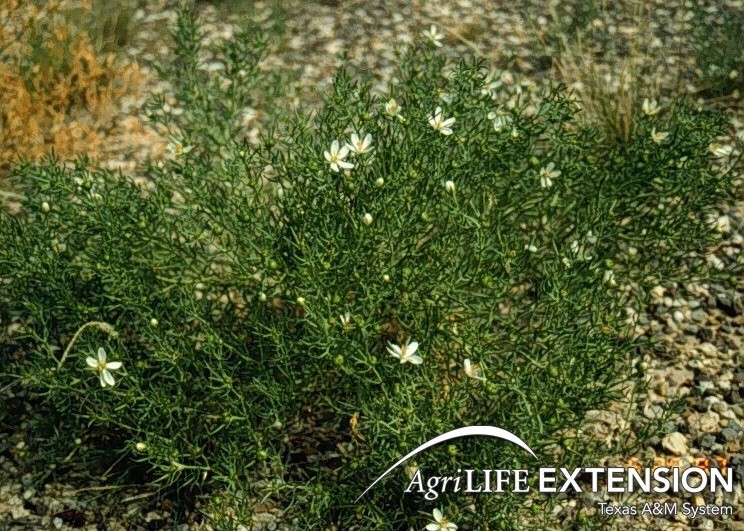Peganum harmala
African Rue
Class: Magnoliopsida
Order: Sapindales
Family: Zygophyllaceae

Source: TAMU AgriLife Extension
Description
The African rue, Peganum harmala, is a multi-branched perennial that grows to higher than 2 feet and about 4 feet in diameter. The base is woody and roots can branch and reach 20 feet in depth, making them able to survive is very dry habitats. Flowers are white with five petals and appear in from spring to early fall. The fruits are located within leathery capsules that contain 45-60 dark brown seeds. The stems have a disagreeable odor when crushed and are bright green, smooth and fleshy. The leaves are alternate, smooth and fleshy like the stems, and divided with long narrow segments. This plant is dangerous because it is toxic. The most toxic part of the plant are the seeds and fruits. A lethal dose is only 0.15% of an animal’s body weight. Young leaves are slightly less toxic and a lethal dose is 1.0% of an animal’s body weight. Signs of livestock ingestion include loss of appetite, weakness of the hind legs, trembling and a lowered body temperature. Postmortem examinations have shown hemorrhages on the heart and liver.
Ecological Threat: Peganum harmala is a very poisonous plant. It possesses four alkaloids that make it lethal to humans and livestock. Additionally, this perennial has an aggressive woody root system that allows it to quickly invade an area. It easily outcompetes native plants by germinating earlier in the spring and producing allelopathic chemicals that reduce the growth of other vegetation. It is declared as a noxious weed in Arizona, California, Colorado, New Mexico, Nevada and Oregon.
Biology: Africa rue reproduces both vegetative and by seeds. Flowers appear and seeds germinate in the early spring and stay present until the fall.
History: It was planted in New Mexico in 1928 by a farmer wanting to produce the dye “Iranian red” from the seeds, which is commonly done in its native lands. It then invasively spread from there and naturalized itself in Arizona and west Texas. By 1967 it had spread to California, Nevada and Oregon.
U.S. Habitat: It is extremely drought tolerant allowing it to thrive in dry habitats like desert rangelands, caliche roadsides and caliche oilfield pad sites.
Distribution
Native Origin: Africa and the Middle East to India
U.S. Present: AZ, CA, ID, MT, NM, NV, OR, TX, WA
Management
The toxic seeds of this plant have shown to have benefits in the pharmaceutical industry as an antidepressant. However, as an invasive plat it is most unwelcomed. Due to the aggressive nature, the plant is extremely hard to control with physical techniques. Mowing stimulates vegetative growth and therefore causes the plant to re-sprout and spread further. Pulling even small plants is nearly impossible because their deep and extensive root system. Chemical control is the most economical way to control this plant. Large areas that are heavily infested are best managed with broadcast herbicide; and individual plant treatment methods are best for smaller areas. Due to the habitat in which it grows, soil-applies herbicides are not effective, especially in caliche soils. Application of herbicides in the fall provides the best results.
Information on useful herbicides and applications thereof, click here.
Text References
Whitson, T.D.(ed.), L.C. Burrill, S.A. Dewey, D.W. Cudney, B.E. Nelson, R.D. Lee, R. Parker. 1996. African rue. Weeds of the West. Western Society of Weed Science, in cooperation with the Western United States Land Grant Universities Cooperative Extension Services, Newark CA. pg. 598.
Internet Sources
http://www.invasiveweeds.com/dirty/african_rue/welcome.html
http://www.oregon.gov/ODA/PLANT/WEEDS/pages/profile_africanrue.aspx
http://www.cwma.org/AfricanRue.html
http://essmextension.tamu.edu/plants/plant/african-rue/
http://pecosbasin.tamu.edu/media/2652/l-5429.pdf
 Texas Invasive Species Institute
Texas Invasive Species Institute